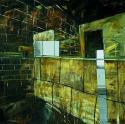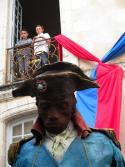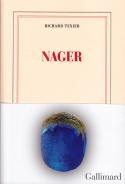Art Of The Day Weekly
#390 - from 28 May 2015 to 3 June 2015
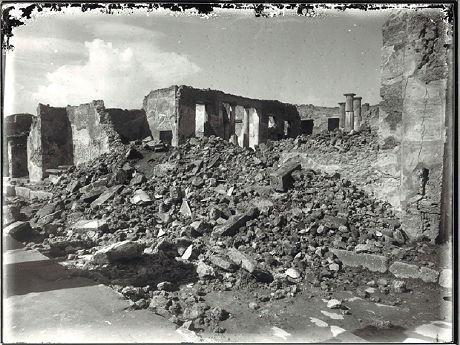
House of M. Epidius Rufus, 1943, photograph; 17,7x23,8cm. Archivio fotografico Soprintendenza speciale per Pompei, Ercolano e Stabia, inv. B provv. 5
IN THE AIR
When the allies bombed Pompeii
NAPLES – In 1738 the site of Herculanum was discovered and in 1748 Pompeii was unearthed. For more than 250 years the apocalyptical eruption and the destiny of a city all imagined more libertine than Sodom fed the collective European imagination. Gustave Moreau and Alma-Tadema underwent the same fascination as Picasso and Chirico. The imposing figure of Super Intendant Giuseppe Fiorelli, who invented a molding technique to keep the body set in the throes of death, is mentioned in the exhibition. But what impresses the viewer most is another ill-known event. On 24 August, then from 13 to 26 September 1943, the Anglo-American air force –suspecting the presence of German soldiers- pounded Pompeii. War has made us used to a number of atrocities. But the decision to bomb ruins of such importance was an extreme choice which - according to true conoscenti –was not justified by the real danger. As the tragic destiny of Palmyra mobilizes people the world over. Damage was colossal: aside from the buildings destroyed, such as the houses of Triptolemus, of Romulus and Remus, the district of Porta Marina, etc., in the only Antiquarium that was used at the time as an exhibition hall, 1378 objects that belonged to every-day life in Pompeii were reduced to dust. Were the general of the allied military headquarters historians? 24 August 1943 was the anniversary of the destruction of Pompeii in 79 A.D. A strange symbol.
• Pompei e l’Europa, 1748-1943 at the Museo Archeologico Nazionale, from 26 May to 2 November 2015. Catalogue Electa, 400 p., €40.
• Recommended reading: Danni di guerra a Pompei. Una vicenda quasi dimenticata, by Laurentino García y García, « L’Erma » di Bretschneider, 2006.
EXHIBITIONS
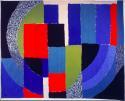
Sonia Delaunay, Drakkar, 1972. Purchase Pierre Daquin, 2000, Angers, musées © Musées d’Angers, Pierre David.
An ode to tapestries
ANGERS - Louise Bourgeois, Georges Braque, Sonia Delaunay, Annette Messager, Pablo Picasso: what do all these artists have in common? They all nourished the creation of XXth century tapestries. Angers, which owns the beautiful Chant du monde by Jean Lurçat and which is the custodian of the famous Tenture de l’Apocalypse, is one of the major venues of tapestry in France. Even though the Musée d’art moderne de la Ville de Paris bought tapestries systematically in the 70s and 80s, while an artist like Alighiero e Boetti dedicated an important part of his work to that form of art, the enthusiasm seems to have mellowed out. The art of tapestry needs a new impulse. It is a technique that requires time, qualified persons, and a dose of humility. These virtues are not always found among the les artists in vogue and the ever powerful market!
• Tapisserie ? De Picasso à Messager, at the musée Jean-Lurçat et de la tapisserie contemporaine, from 23 May to 31 Octobre 2015.
Lee and Pablo
EDIMBURGH – He painted her six times, she photographed him over oen thousand times. He was Pablo Picasso, she was Lee Miller, currently exhibited at the Albertina in Vienna. Their relationship started in Mougins in 1937 and only ended with the demise of Picasso in 1973. Roland Penrose, Lee Miller’s companion, was actually one of the painter’s main biographers.
• Lee Miller and Picasso at the Scottish National Portrait Gallery, from 23 May to 6 September 2015.
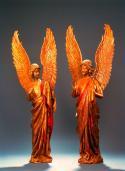
Saudemont Angels, Northern France, ca 1270-1300, wood, polychromy, Arras, Musée des Beaux-Arts © Musée des Beaux-Arts d’Arras / Claude Thériez
1300, the Paris-Florence axis
LENS – We hear the word Globalization at nauseum! Is it as new as they say? Did man wait for internet, the jet and the cellphone to transmit fashions and tendencies? As we can see in the artistic exchanges that took place in periods that seem far and gone, nothing is less obvious. In the Middle Ages for example saints’ relics were the source of an impressive traffic across the continent. Furthermore, as can be seen in this exhibition, artistic innovations were spread without worrying about borders: on the eve of the 1348 Bubonic plague, the Northern French Gothic virtuosities, sculpted on bone or ivory, the illuminations for Philippe III le Hardi, angels and the Magi in limestone and enamels irrigated Tuscany with a continuous flux which influenced its artists. More than one hundred works of art lent by the Louvre as well as by the museums of Arras and Cambrai, the Bargello in Florence or the Manchester City Galleries illustrate this rich dialogue.
• D’or et d’ivoire. Paris, Pise, Florence, Sienne, 1250-1320 at the Louvre Lens, from 27 May to 28 September 2015.
Kiesler, too often forgotten
VIENNA – in spite of a beautiful exhibition at the Centre Pompidou in 1996, Frederick Kiesler (1890-1965) is one of the most ill-known Jack of all trades of the XXth century. He was an architect, a sculptor, a theoretician and a remarkable writer of memoirs. He is the one we can thank for mythical installations during major Surrealist events at Peggy Guggenheim’s as well as the Sanctuary of books in Jerusalem. The exhibition focuses in particular on his activity as a set designer.
• Function Follows Vision, Vision Follows Reality at the Kunsthalle Wien, from 27 May to 23 August 2015.
Three decades of Oehlen
ZURICH – The enfant terrible of German painting, Albert Oehlen comes back to one of the first museums to have dedicated an ambitious retrospective to him in 1987. Born in 1954, the artist looks back at his itinerary during the 1980s, and completes it with his most recent production. Did he metamorphose? Is he loyal to his principles?
• Albert Oehlen at the Zürich Kunsthalle from 30 May to 16 August 2015.
ARTIST OF THE WEEK
Ousmane Sow, a giant from Africa
His name was included in the Petit Larousse dictionary in 2005 and he entered the Académie des Beaux-Arts (Academy of Fine Arts) in 2013, when he inherited the seat that was Rossini’s and then of American painter Andrew Wyeth. This Senegalese artist was revealed to the general public in 1999 with the exhibition of his colossal figures on the Passerelle des Arts in Paris. The itinerary of this African, the second black man to be introduced to the Coupole after Leopold Sedar Senghor, is rather original. He was not able to present the contest to enter the Beaux Arts de Paris, so he practiced physical therapy until the age of 50. This experience gave him deep knowledge of the human anatomy and of movement, which is translated into his oversized, often heroical characters, such as Mandela. On 19 November 2014, the artist broke his own record during a sale at Millon auction house: €410,000 for his group of Zoulous, done in 1990 in a mixed paste of tar, resin, gasoline, glue and twenty other mysterious elements. On 21 May 2015, his gigantic bronze Toussaint-Louverture was inaugurated at La Rochelle.
• Recommended reading: Ousmane Sow, by Françoise Monnin, photographs by Béatrice Soulié, published by Ides et Calendes, 2014, 128 p., €24.
OPENINGS OF THE WEEK

Isabelle Le Minh STRANGER THAN PARADIGM
30 May 2015 - PARIS - Galerie Christophe Gaillard
What is photography? A medium? An idea? A weapon?
BOOKS
Richard Texier remembers
Artists often have vague memories about their vocation. That is not the case of Richard Texier. In this book of memoirs he describes with mathematical precision what triggered off his desire to embrace the career of paintbrushes. He was in sixth grade and it is in volume 5 of the Lagarde et Michard literature textbook, on page 352. There are two reproductions presented side by side: a Miró and most important, a work by Tanguy, Jour de lenteur. After a childhood in the region of Charente, young Texier grew up in Niort, a town where the one and only bookstore has a very meager art section and nothing on Tanguy! The exploration, in the pre-internet era, was very slow but in the long run pleasure filled and sociable. The young man, inoculated forever with the art virus by this Surrealist artist, would succeed in discovering who this Tanguy was: he who in turn had gone to seek his fortune in the USA with his friend Pierre Matisse. As a result, Texier, the grandson of hunters and fishermen, the son of yeast and sweets merchants, the friend of gardeners specialized in poplars, definitely chose his path, which was completely different, painting. The book talks of his more recent friends, such as Zao Wou-ki who opened the doors to China for him, but the smell that most stays with him is that of the workshop of his first master: it smelled of turpentine, linseed oil and Courtrai drier.
• Nager, by Richard Texier, Gallimard, 2015, 240 p., €19.
IN BRIEF
FONTAINEBLEAU – The 5th festival of the history of art will be held from 29 to 31 May 2015 with the Netherands as the invited guest.
PARIS - Choices Paris, "Collectors Weekend", will be held from 29 to 31 May 2015, in 40 galleries.
PARIS - Art Saint-Germain-des-Prés, an event of galleries, will be held from 28 to 31 May 2015.
VENICE – The Icelandic pavilion of the Biennale, a temporary mosque set up in disaffected chruch, Santa Marie della Misericordia, was closed on 22 May by the police.

